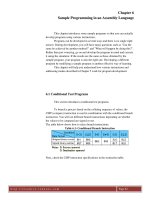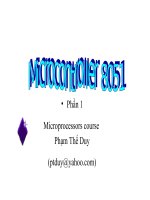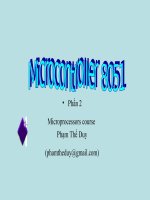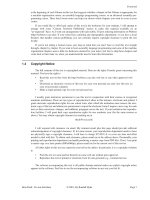Microcontroller 8051 - assembly language ppt
Bạn đang xem bản rút gọn của tài liệu. Xem và tải ngay bản đầy đủ của tài liệu tại đây (270.69 KB, 40 trang )
Numerical Bases Used in Programming
•
Hexadecimal
•
Binary
•
BCD
Hexadecimal Basis
•
Hexadecimal Digits:
1 2 3 4 5 6 7 8 9 A B C D E F
A=10
B=11
C=12
D=13
E=14
F=15
Decimal, Binary, BCD, & Hexadecimal Numbers
(43)
10
=
(0100 0011)
BCD
=
( 0010 1011 )
2
=
( 2 B )
16
Register
s
A
B
R0
R1
R3
R4
R2
R5
R7
R6
DPH DPL
PC
DPTR
PC
Some 8051 16-bit Register
Some 8-bitt Registers of
the 8051
SP
Memory mapping in 8051
•
ROM memory map in 8051 family
0000H
0FFFH
0000H
1FFFH
8751
AT89C51
8752
AT89C52
4k 8k
•
RAM memory space allocation in the 8051
7FH
30H
2FH
20H
1FH
17H
10H
0FH
07H
08H
18H
00H
Register Bank 0
)Stack) Register Bank 1
Register Bank 2
Register Bank 3
Bit-Addressable RAM
Scratch pad RAM
Addressing Modes
•
Register
•
Direct
•
Register Indirect
•
Immediate
•
Relative
•
Absolute
•
Long
•
Indexed
Register Addressing Mode
MOV Rn, A ;n=0, ,7
ADD A, Rn
MOV DPL, R6
MOV DPTR, A
MOV Rm, Rn
Direct Addressing Mode
Although the entire of 128 bytes of RAM can be
accessed using direct addressing mode, it is most often
used to access RAM loc. 30 – 7FH.
MOV R0, 40H
MOV 56H, A
MOV A, 4 ; ≡ MOV A, R4
MOV 6, 2 ; copy R2 to R6
; MOV R6,R2 is invalid !
Register Indirect Addressing Mode
•
In this mode, register is used as a pointer to the data.
MOV A,@Ri ; move content of RAM loc.
where address is held by Ri into A ( i=0 or 1 )
MOV @R1,B
In other word, the content of register R0 or R1 is
sources or target in MOV, ADD and SUBB insructions.
Immediate Addressing Mode
MOV A,#65H
MOV R6,#65H
MOV DPTR,#2343H
MOV P1,#65H
Relative, Absolute, & Long Addressing
Used only with jump and call instructions:
SJMP
ACALL,AJMP
LCALL,LJMP
Indexed Addressing Mode
•
This mode is widely used in accessing data
elements of look-up table entries located in the
program (code) space ROM at the 8051
MOVC A,@A+DPTR
(A,@A+PC)
A= content of address A +DPTR from ROM
Note:
Because the data elements are stored in the
program (code ) space ROM of the 8051, it uses
the instruction MOVC instead of MOV. The “C”
means code.
Some Simple Instructions
MOV dest,source ; dest = source
MOV A,#72H ;A=72H
MOV R4,#62H ;R4=62H
MOV B,0F9H ;B=the content of F9’th byte of RAM
MOV DPTR,#7634H
MOV DPL,#34H
MOV DPH,#76H
MOV P1,A ;mov A to port 1
Note 1:
MOV A,#72H ≠ MOV A,72H
After instruction “MOV A,72H ” the content of 72’th byte of RAM will
replace in Accumulator.
Note 2:
MOV A,R3 ≡ MOV A,3
ADD A, Source ;A=A+SOURCE
ADD A,#6 ;A=A+6
ADD A,R6 ;A=A+R6
ADD A,6 ;A=A+[6] or A=A+R6
ADD A,0F3H ;A=A+[0F3H]
SUBB A, Source ;A=A-SOURCE-C
SUBB A,#6 ;A=A-6
SUBB A,R6 ;A=A+R6
MUL & DIV
•
MUL AB ;B|A = A*B
MOV A,#25H
MOV B,#65H
MUL AB ;25H*65H=0E99
;B=0EH, A=99H
•
DIV AB ;A = A/B, B = A mod B
MOV A,#25
MOV B,#10
DIV AB ;A=2, B=5
SETB bit ; bit=1
CLR bit ; bit=0
SETB C ; CY=1
SETB P0.0 ;bit 0 from port 0 =1
SETB P3.7 ;bit 7 from port 3 =1
SETB ACC.2 ;bit 2 from ACCUMULATOR =1
SETB 05 ;set high D5 of RAM loc. 20h
Note:
CLR instruction is as same as SETB
i.e.:
CLR C ;CY=0
But following instruction is only for CLR:
CLR A ;A=0
DEC byte ;byte=byte-1
INC byte ;byte=byte+1
INC R7
DEC A
DEC 40H ; [40]=[40]-1
RR – RL – RRC – RLC A
EXAMPLE:
RR A
RR:
RRC:
RL:
RLC:
C
C
ANL - ORL – XRL
Bitwise Logical Operations:
AND, OR, XOR
EXAMPLE:
MOVR5,#89H
ANL R5,#08H
CPL A ;1’s complement
Example:
MOV A,#55H ;A=01010101 B
L01: CPL A
MOV P1,A
ACALL DELAY
SJMP L01
Stack in the 8051
•
The register used to access
the stack is called SP
(stack pointer) register.
•
The stack pointer in the
8051 is only 8 bits wide,
which means that it can
take value 00 to FFH.
When 8051 powered up,
the SP register contains
value 07.
7FH
30H
2FH
20H
1FH
17H
10H
0FH
07H
08H
18H
00H
Register Bank 0
)Stack) Register Bank 1
Register Bank 2
Register Bank 3
Bit-Addressable RAM
Scratch pad RAM
Example:
MOV R6,#25H
MOV R1,#12H
MOV R4,#0F3H
PUSH 6
PUSH 1
PUSH 4
0BH
0AH
09H
08H
Start SP=07H
25
0BH
0AH
09H
08H
SP=08H
F3
12
25
0BH
0AH
09H
08H
SP=08H
12
25
0BH
0AH
09H
08H
SP=09H
LOOP and JUMP Instructions
JZ Jump if A=0
JNZ Jump if A/=0
DJNZ Decrement and jump if A/=0
CJNE A,byte Jump if A/=byte
CJNE reg,#data Jump if byte/=#data
JC Jump if CY=1
JNC Jump if CY=0
JB Jump if bit=1
JNB Jump if bit=0
JBC Jump if bit=1 and clear bit
Conditional Jumps :
DJNZ:
Write a program to clear ACC, then
add 3 to the accumulator ten time
Solution:
MOV A,#0
MOV R2,#10
AGAIN: ADD A,#03
DJNZ R2,AGAIN ;repeat until R2=0 (10 times)
MOV R5,A









